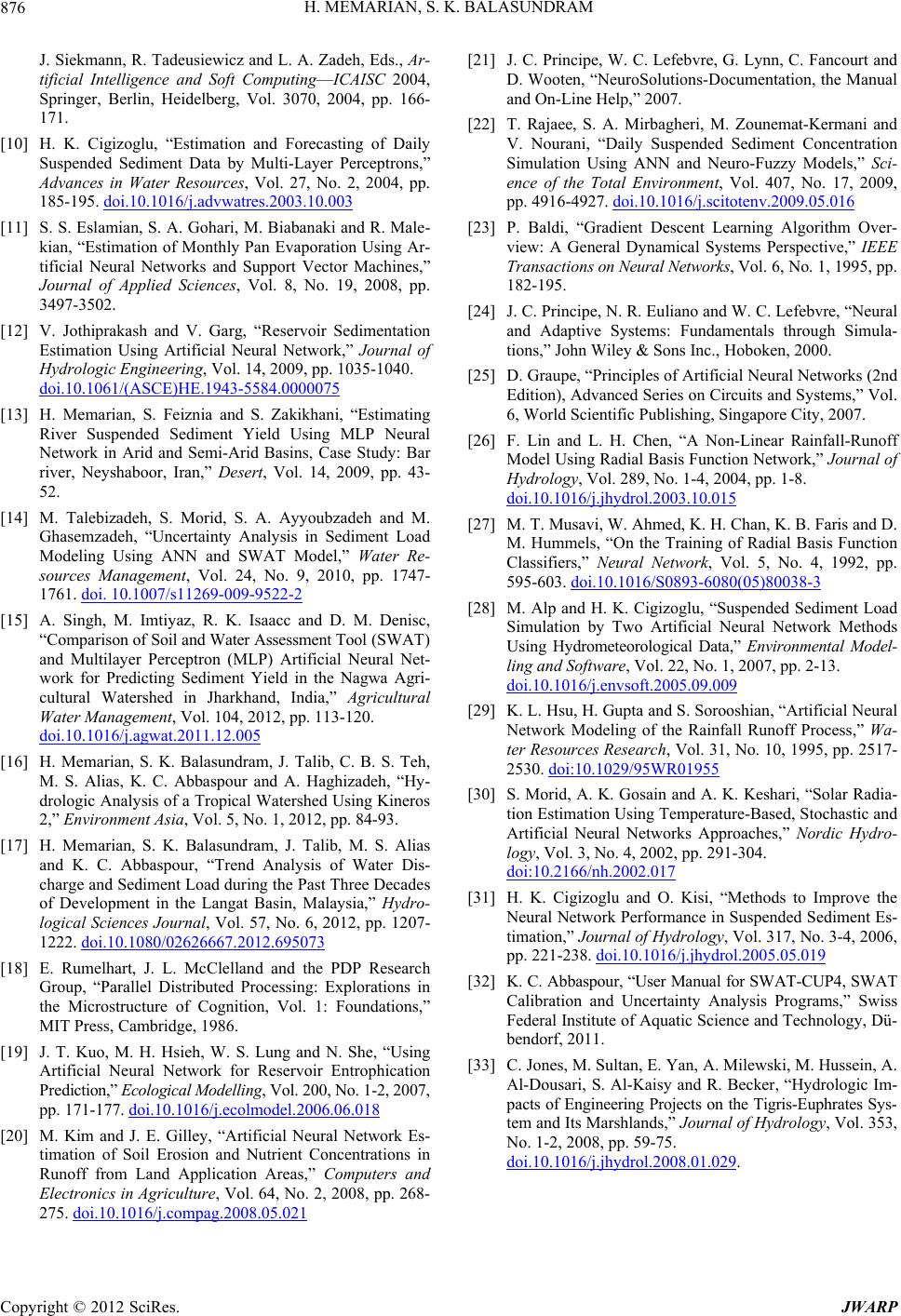
H. MEMARIAN, S. K. BALASUNDRAM
876
J. Siekmann, R. Tadeusiewicz and L. A. Zadeh, Eds., Ar-
tificial Intelligence and Soft Computing—ICAISC 2004,
Springer, Berlin, Heidelberg, Vol. 3070, 2004, pp. 166-
171.
[10] H. K. Cigizoglu, “Estimation and Forecasting of Daily
Suspended Sediment Data by Multi-Layer Perceptrons,”
Advances in Water Resources, Vol. 27, No. 2, 2004, pp.
185-195. doi.10.1016/j.advwatres.2003.10.003
[11] S. S. Eslamian, S. A. Gohari, M. Biabanaki and R. Male-
kian, “Estimation of Monthly Pan Evaporation Using Ar-
tificial Neural Networks and Support Vector Machines,”
Journal of Applied Sciences, Vol. 8, No. 19, 2008, pp.
3497-3502.
[12] V. Jothiprakash and V. Garg, “Reservoir Sedimentation
Estimation Using Artificial Neural Network,” Journal of
Hydrologic Engineering, Vol. 14, 2009, pp. 1035-1040.
doi.10.1061/(ASCE)HE.1943-5584.0000075
[13] H. Memarian, S. Feiznia and S. Zakikhani, “Estimating
River Suspended Sediment Yield Using MLP Neural
Network in Arid and Semi-Arid Basins, Case Study: Bar
river, Neyshaboor, Iran,” Desert, Vol. 14, 2009, pp. 43-
52.
[14] M. Talebizadeh, S. Morid, S. A. Ayyoubzadeh and M.
Ghasemzadeh, “Uncertainty Analysis in Sediment Load
Modeling Using ANN and SWAT Model,” Water Re-
sources Management, Vol. 24, No. 9, 2010, pp. 1747-
1761. doi. 10.1007/s11269-009-9522-2
[15] A. Singh, M. Imtiyaz, R. K. Isaacc and D. M. Denisc,
“Comparison of Soil and Water Assessment Tool (SWAT)
and Multilayer Perceptron (MLP) Artificial Neural Net-
work for Predicting Sediment Yield in the Nagwa Agri-
cultural Watershed in Jharkhand, India,” Agricultural
Water Management, Vol. 104, 2012, pp. 113-120.
doi.10.1016/j.agwat.2011.12.005
[16] H. Memarian, S. K. Balasundram, J. Talib, C. B. S. Teh,
M. S. Alias, K. C. Abbaspour and A. Haghizadeh, “Hy-
drologic Analysis of a Tropical Watershed Using Kineros
2,” Environment Asia, Vol. 5, No. 1, 2012, pp. 84-93.
[17] H. Memarian, S. K. Balasundram, J. Talib, M. S. Alias
and K. C. Abbaspour, “Trend Analysis of Water Dis-
charge and Sediment Load during the Past Three Decades
of Development in the Langat Basin, Malaysia,” Hydro-
logical Sciences Journal, Vol. 57, No. 6, 2012, pp. 1207-
1222. doi.10.1080/02626667.2012.695073
[18] E. Rumelhart, J. L. McClelland and the PDP Research
Group, “Parallel Distributed Processing: Explorations in
the Microstructure of Cognition, Vol. 1: Foundations,”
MIT Press, Cambridge, 1986.
[19] J. T. Kuo, M. H. Hsieh, W. S. Lung and N. She, “Using
Artificial Neural Network for Reservoir Entrophication
Prediction,” Ecological Modelling, Vol. 200, No. 1-2, 2007,
pp. 171-177. doi.10.1016/j.ecolmodel.2006.06.018
[20] M. Kim and J. E. Gilley, “Artificial Neural Network Es-
timation of Soil Erosion and Nutrient Concentrations in
Runoff from Land Application Areas,” Computers and
Electronics in Agriculture, Vol. 64, No. 2, 2008, pp. 268-
275. doi.10.1016/j.compag.2008.05.021
[21] J. C. Principe, W. C. Lefebvre, G. Lynn, C. Fancourt and
D. Wooten, “NeuroSolutions-Documentation, the Manual
and On-Line Help,” 2007.
[22] T. Rajaee, S. A. Mirbagheri, M. Zounemat-Kermani and
V. Nourani, “Daily Suspended Sediment Concentration
Simulation Using ANN and Neuro-Fuzzy Models,” Sci-
ence of the Total Environment, Vol. 407, No. 17, 2009,
pp. 4916-4927. doi.10.1016/j.scitotenv.2009.05.016
[23] P. Baldi, “Gradient Descent Learning Algorithm Over-
view: A General Dynamical Systems Perspective,” IEEE
Transactions on Neural Networks, Vol. 6, No. 1, 1995, pp.
182-195.
[24] J. C. Principe, N. R. Euliano and W. C. Lefebvre, “Neural
and Adaptive Systems: Fundamentals through Simula-
tions,” John Wiley & Sons Inc., Hoboken, 2000.
[25] D. Graupe, “Principles of Artificial Neural Networks (2nd
Edition), Advanced Series on Circuits and Systems,” Vol.
6, World Scientific Publishing, Singapore City, 2007.
[26] F. Lin and L. H. Chen, “A Non-Linear Rainfall-Runoff
Model Using Radial Basis Function Network,” Journal of
Hydrology, Vol. 289, No. 1-4, 2004, pp. 1-8.
doi.10.1016/j.jhydrol.2003.10.015
[27] M. T. Musavi, W. Ahmed, K. H. Chan, K. B. Faris and D.
M. Hummels, “On the Training of Radial Basis Function
Classifiers,” Neural Network, Vol. 5, No. 4, 1992, pp.
595-603. doi.10.1016/S0893-6080(05)80038-3
[28] M. Alp and H. K. Cigizoglu, “Suspended Sediment Load
Simulation by Two Artificial Neural Network Methods
Using Hydrometeorological Data,” Environmental Model-
ling and Software, Vol. 22, No. 1, 2007, pp. 2-13.
doi.10.1016/j.envsoft.2005.09.009
[29] K. L. Hsu, H. Gupta and S. Sorooshian, “Artificial Neural
Network Modeling of the Rainfall Runoff Process,” Wa-
ter Resources Research, Vol. 31, No. 10, 1995, pp. 2517-
2530. doi:10.1029/95WR01955
[30] S. Morid, A. K. Gosain and A. K. Keshari, “Solar Radia-
tion Estimation Using Temperature-Based, Stochastic and
Artificial Neural Networks Approaches,” Nordic Hydro-
logy, Vol. 3, No. 4, 2002, pp. 291-304.
doi:10.2166/nh.2002.017
[31] H. K. Cigizoglu and O. Kisi, “Methods to Improve the
Neural Network Performance in Suspended Sediment Es-
timation,” Journal of Hydrology, Vol. 317, No. 3-4, 2006,
pp. 221-238. doi.10.1016/j.jhydrol.2005.05.019
[32] K. C. Abbaspour, “User Manual for SWAT-CUP4, SWAT
Calibration and Uncertainty Analysis Programs,” Swiss
Federal Institute of Aquatic Science and Technology, Dü-
bendorf, 2011.
[33] C. Jones, M. Sultan, E. Yan, A. Milewski, M. Hussein, A.
Al-Dousari, S. Al-Kaisy and R. Becker, “Hydrologic Im-
pacts of Engineering Projects on the Tigris-Euphrates Sys-
tem and Its Marshlands,” Journal of Hydrology, Vol. 353,
No. 1-2, 2008, pp. 59-75.
doi.10.1016/j.jhydrol.2008.01.029.
Copyright © 2012 SciRes. JWARP